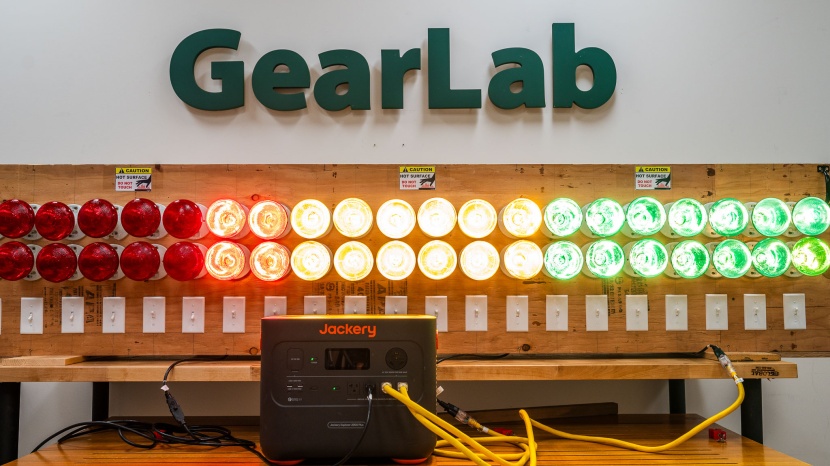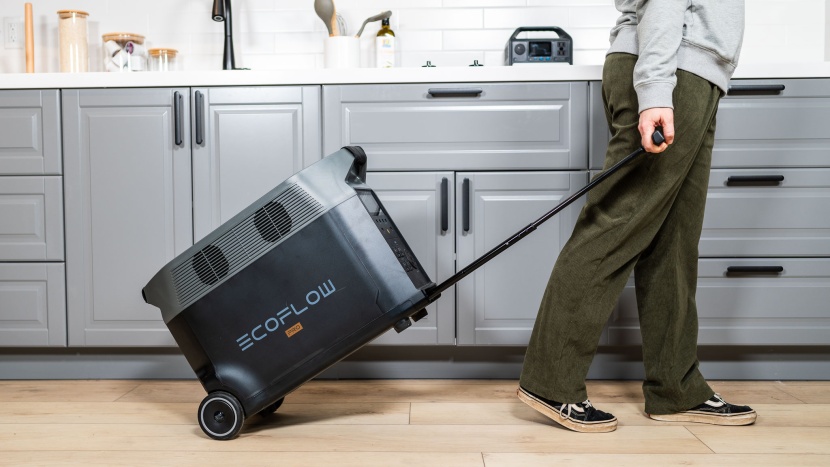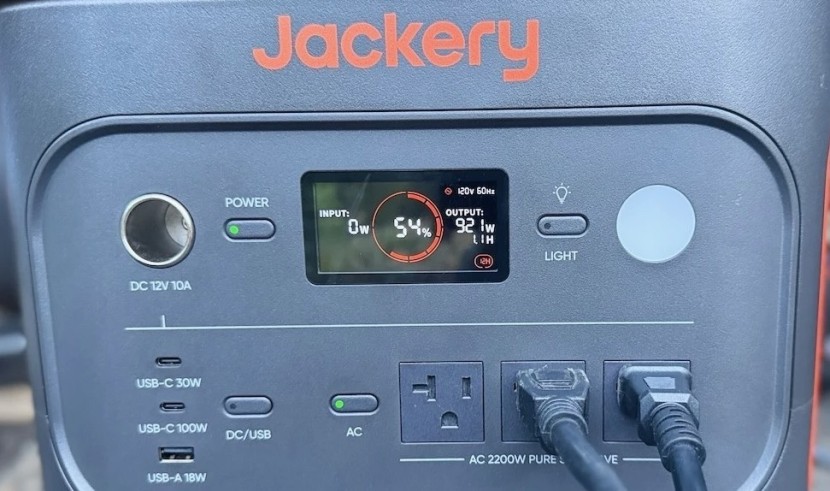To evaluate power stations, our team first engaged in extensive hands-on use in real-world situations, such as off-grid camping or simulating a power outage at home. We combined that extensive hands-on experience with lab testing to precisely determine the actual performance each product can deliver.
Power Output
The most heavily weighted metric in our tests is the power output metric, which focuses on each model's actual capability for power and battery capacity when used in real-world conditions.
Rather than rely on the manufacturer's claims, we developed a custom power output testing jig that allows us to measure the actual power output available through each power station's AC outlets.
The light bar set up that is shown in the photo below allows us to dial up a specific AC power load, burdening each power station with approximately 80% of its rated maximum wattage load, and then we use AC power testing instruments to accurately measure the power output each product can produce from 100% charged to fully exhausted.
We also measured the “usable” percentage of the claimed capacity. To calculate the usable percentage, we use our precise measurement of the actual power available through the AC outlets, and divide that by the manufacturer's claimed capacity. So, if a power station had a claimed capacity of 1,000 watt-hours, and we measured that 820 watt-hours were actually available from the AC outlets, we'd calculate an 82% usable capacity (Usable Capacity % = Measured Power Output / Claimed Capacity). It should come as no surprise that none of the power stations achieve 100% usable capacity due primarily to losses in the conversion from DC battery to AC electricity. The usable capacity % varies substantially between competing products, with some offering as less than 70& efficiency and others delivering an impressive >90% efficiency.
Charging Speed
Most people would not guess at the dramatic variation in charging speeds among power stations. Our tests show that some products can be fully charged in less than 2 hours, while others take more than 12 hours!
That can really make a difference in practical use. Imagine you are getting ready for a camping trip, and realize you forgot to charge up your power station. Or, a big storm is coming in that might result in a sustained power outage. Being able to get your power station charged in a few hours can be a big advantage.
To test charging speed, we fully drained the battery and then measured the time to fully charge using AC power. We also noted any significant charging features equipped on each model. Some brands offer increased charging speeds by toggling a button either on the power station itself or through a mobile app.
Portability
Our Portability metric looks at the effort required to lift and carry, the ability to roll over different surfaces, and the different dimensions and weights necessary to stack and store your portable power station. In addition to the the obvious differences in weight and physical size, some products incorporate features such as built-in wheels and ergonomic handles to making moving them around easier. Some of the larger power stations we tested require multiple people just to lift them into the car.
Rather than rely on the manufacturer's claims for weight and size, we took our own measurements. And, to get a qualitative feeling for portability, we also moved each power station in and out of different cars, packed them away for a week of camping, and, for those with wheels, we rolled them across uneven terrain. We also gathered input from multiple testers to get feedback on each model's handle and carrying feel to get a better consensus on how each model performed when being lifted and handled.
Features
To be clear, we are fans of simplicity in power stations. We don't want a lot of fancy features, or to feel like we need to download an app to use a power station. It should be easy out of the box, with a clear and simple front panel and controls.
So, while we tested advanced features, and the apps for those products that offer a smartphone app, we put an emphasis on the basic, simple, operation of the power station using its display screen and front panel controls.
The highest scoring products on ease of use incorporate a large, easy-to-read display screen, which makes it easy to see basic information such as % charge remaining, estimated remaining runtime, and other details like wattage input/output. Extra points were awarded for practical features, such as a built-in light or the ability for the product to act as an uninterruptible power supply (UPS).
Smartphone app functionality was also considered, but given less weight in our scoring, since we generally prefer simple, basic, reliable operation over advanced app-enabled functionality.



